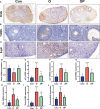PQQ Dietary Supplementation Prevents Alkylating Agent-Induced Ovarian Dysfunction in Mice
- PMID: 35340329
- PMCID: PMC8948422
- DOI: 10.3389/fendo.2022.781404
PQQ Dietary Supplementation Prevents Alkylating Agent-Induced Ovarian Dysfunction in Mice
Abstract
Alkylating agents (AAs) that are commonly used for cancer therapy cause great damage to the ovary. Pyrroloquinoline-quinine (PQQ), which was initially identified as a redox cofactor for bacterial dehydrogenases, has been demonstrated to benefit the fertility of females. The aim of this study was to investigate whether PQQ dietary supplementation plays a protective role against alkylating agent-induced ovarian dysfunction. A single dose of busulphan (20 mg/kg) and cyclophosphamide (CTX, 120 mg/kg) were used to establish a mouse model of ovarian dysfunction. Feed containing PQQNa2 (5 mg/kg) was provided starting 1 week before the establishment of the mouse model until the date of sacrifice. One month later, estrous cycle period of mice were examined and recorded for consecutive 30 days. Three months later, some mice were mated with fertile male mice for fertility test. The remaining mice were sacrificed to collect serum samples and ovaries. One day before sacrifice, some mice received a single injection of BrdU to label proliferating cells. Serum samples were used for test hormonal levels. Ovaries were weighted and used to detect follicle counts, cell proliferation, cell apoptosis and cell senescence. In addition, the levels of inflammation, oxidative damage and Pgc1α expression were detected in ovaries. Results showed that PQQ treatment increased the ovarian weight and size, partially normalized the disrupted estrous cycle period and prevented the loss of follicles of mice treated with AAs. More importantly, we found that PQQ treatment significantly increased the pregnancy rate and litter size per delivery of mice treated with AAs. The protective effects of PQQ appeared to be directly mediated by promoting cell proliferation of granulosa, and inhibiting cell apoptosis of granulosa and cell senescence of ovarian stromal cells. The underlying mechanisms may attribute to the anti-oxidative stress, anti-inflammation and pro-mitochondria biogenesis effects of PQQ.Our study highlights the therapeutic potential of PQQ against ovarian dysfunction caused by alkylating agents.
Keywords: alkylating agents; ovarian aging; ovarian dysfunction; protection; pyrroloquinoline quinine.
Copyright © 2022 Dai, Yi, Wang, Xia, Tao, Wu, Miao and Chen.
Conflict of interest statement
The authors declare that the research was conducted in the absence of any commercial or financial relationships that could be construed as a potential conflict of interest.
Figures





References
Publication types
MeSH terms
Substances
LinkOut - more resources
Full Text Sources

